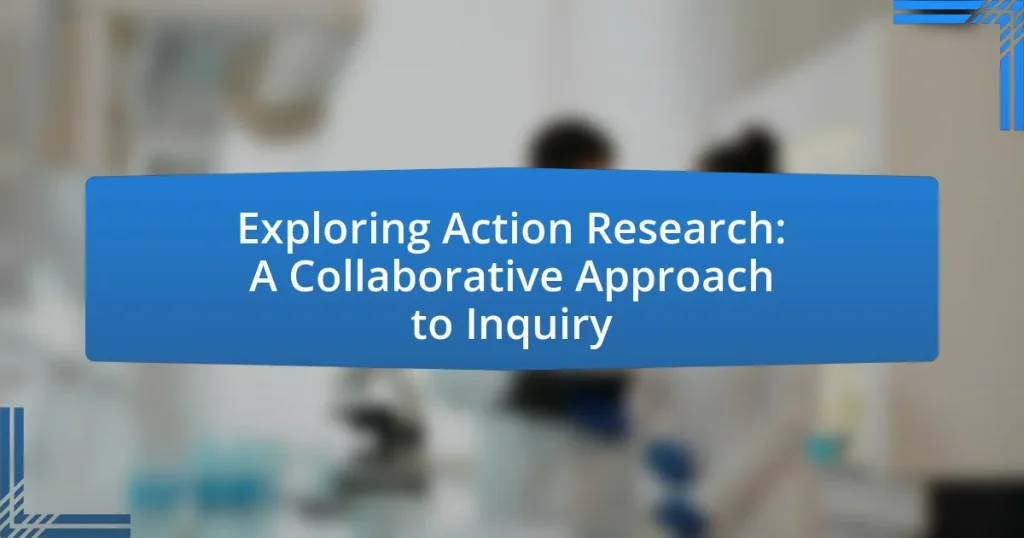Action research is a participatory and iterative methodology aimed at improving practices through cycles of planning, acting, observing, and reflecting. This approach emphasizes collaboration among stakeholders, making it particularly effective in educational settings for enhancing teaching and learning. The article explores the differences between action research and traditional research methods, highlighting its focus on practical problem-solving and real-time application of findings. Key characteristics, stages, and the importance of collaboration in action research are discussed, along with strategies to overcome common challenges and ensure ethical considerations are met. The article also outlines best practices for conducting successful action research, emphasizing the role of reflection and stakeholder engagement in achieving meaningful outcomes.

What is Action Research?
Action research is a participatory and iterative process aimed at improving practices through a cycle of planning, acting, observing, and reflecting. This methodology emphasizes collaboration among stakeholders, allowing them to identify issues, implement solutions, and evaluate outcomes in real-time. Action research is widely used in educational settings to enhance teaching and learning, as evidenced by studies such as those conducted by Kemmis and McTaggart, which highlight its effectiveness in fostering professional development and community engagement.
How does Action Research differ from traditional research methods?
Action Research differs from traditional research methods primarily in its focus on practical problem-solving and collaboration. While traditional research often emphasizes objective analysis and the generation of generalizable knowledge, Action Research is iterative and participatory, involving stakeholders in the research process to address specific issues within their context. This approach allows for immediate application of findings, fostering continuous improvement and adaptation. Evidence of this distinction can be found in the work of Kurt Lewin, who pioneered Action Research in the 1940s, emphasizing its role in social change and community engagement, contrasting with the more detached nature of traditional methodologies.
What are the key characteristics of Action Research?
Action Research is characterized by its iterative process, collaboration, and focus on practical problem-solving. This research methodology involves cycles of planning, acting, observing, and reflecting, allowing practitioners to continuously improve their practices. Collaboration is essential, as it typically involves stakeholders such as educators, researchers, and community members working together to identify issues and develop solutions. Additionally, Action Research emphasizes the application of findings to real-world situations, making it a valuable tool for fostering change and enhancing effectiveness in various contexts.
Why is collaboration essential in Action Research?
Collaboration is essential in Action Research because it enhances the quality and relevance of the inquiry process. Engaging multiple stakeholders, such as educators, researchers, and community members, fosters diverse perspectives, which leads to more comprehensive problem identification and solution development. Research by Stringer (2014) in “Action Research” highlights that collaborative efforts result in shared ownership of the research process, increasing commitment to implementing findings. This collective approach not only enriches data collection but also ensures that the interventions are contextually appropriate and sustainable, ultimately improving outcomes.
What are the stages of the Action Research process?
The stages of the Action Research process include identifying a problem, planning an intervention, implementing the intervention, observing the effects, and reflecting on the results. This cyclical process allows practitioners to continuously improve their practices through iterative cycles of inquiry and reflection. Each stage is essential for gathering data, analyzing outcomes, and making informed decisions for future actions, thereby enhancing the overall effectiveness of the research.
How do planning and action phases contribute to the research cycle?
The planning and action phases are critical components of the research cycle as they establish the framework for inquiry and facilitate the implementation of research strategies. During the planning phase, researchers identify objectives, formulate research questions, and design methodologies, which provide a structured approach to data collection and analysis. This phase ensures that the research is focused and relevant, aligning with the goals of the inquiry.
In the action phase, researchers execute the planned strategies, collecting data and engaging with participants, which allows for real-time adjustments based on findings. This iterative process enhances the research’s adaptability and responsiveness to emerging insights. For instance, in action research, the cyclical nature of planning and action enables continuous reflection and refinement, leading to more robust outcomes. The integration of these phases fosters a comprehensive understanding of the research context and promotes collaborative inquiry, ultimately contributing to the validity and reliability of the research findings.
What role does reflection play in Action Research?
Reflection plays a critical role in Action Research by facilitating continuous learning and improvement. It allows researchers to analyze their experiences, assess the effectiveness of their interventions, and make informed decisions for future actions. This iterative process of reflection enhances the quality of the research by promoting deeper understanding and adaptation to changing circumstances, ultimately leading to more effective practices. Studies have shown that reflective practices in Action Research contribute to better outcomes, as they encourage critical thinking and foster a culture of inquiry among participants.
What are the goals of Action Research?
The goals of Action Research are to improve practices, enhance understanding, and foster collaboration among participants. Action Research aims to identify specific issues within a community or organization, implement interventions, and evaluate their effectiveness through iterative cycles of reflection and action. This approach not only seeks to address immediate problems but also promotes a culture of continuous learning and adaptation, as evidenced by its widespread use in educational settings to enhance teaching strategies and student outcomes.
How does Action Research aim to improve practice?
Action Research aims to improve practice by systematically investigating and reflecting on one’s own professional actions to enhance effectiveness. This approach involves a cyclical process of planning, acting, observing, and reflecting, which allows practitioners to identify areas for improvement and implement changes based on evidence gathered during the research. For instance, a study by Stringer (2014) emphasizes that Action Research fosters collaboration among stakeholders, enabling shared insights that lead to more informed decision-making and better outcomes in educational settings.
What impact does Action Research have on participant engagement?
Action Research significantly enhances participant engagement by fostering collaboration and active involvement in the research process. This approach encourages participants to contribute their insights and experiences, leading to a sense of ownership over the outcomes. Studies, such as those by Stringer (2014) in “Action Research” and Kemmis & McTaggart (2000) in “The Action Research Planner,” demonstrate that when participants are actively engaged in the inquiry, they are more likely to be motivated and invested in the results, ultimately improving the effectiveness of the research.

Why is Collaboration Important in Action Research?
Collaboration is important in action research because it enhances the quality and relevance of the research findings. Engaging multiple stakeholders, such as educators, researchers, and community members, fosters diverse perspectives that contribute to a more comprehensive understanding of the issues being investigated. Research indicates that collaborative action research leads to improved problem-solving and innovation, as evidenced by a study published in the “Journal of Educational Action Research,” which found that collaborative teams produced more effective interventions than individuals working alone. This collective effort not only enriches the data collected but also promotes shared ownership of the outcomes, ultimately leading to more sustainable changes in practice.
How does collaboration enhance the research outcomes?
Collaboration enhances research outcomes by integrating diverse perspectives and expertise, leading to more comprehensive and innovative solutions. When researchers from various disciplines work together, they can address complex problems more effectively, as evidenced by studies showing that interdisciplinary teams produce higher-quality publications and more impactful findings. For instance, a study published in the journal “Nature” found that collaborative research efforts significantly increased citation rates, indicating greater influence and relevance in the scientific community. This synergy not only fosters creativity but also accelerates the research process, ultimately resulting in more robust and applicable outcomes.
What are the benefits of involving multiple stakeholders in Action Research?
Involving multiple stakeholders in Action Research enhances the quality and relevance of the research outcomes. This collaborative approach allows for diverse perspectives, which leads to a more comprehensive understanding of the issues being studied. For instance, stakeholders such as educators, students, and community members contribute unique insights that can identify practical solutions and foster ownership of the research process. Research by Stringer (2014) in “Action Research” highlights that stakeholder involvement increases the validity of findings, as it reflects a broader range of experiences and contexts. Additionally, engaging multiple stakeholders promotes shared responsibility and accountability, which can lead to more sustainable changes in practice.
How can diverse perspectives improve the research process?
Diverse perspectives can significantly improve the research process by enhancing creativity, fostering critical thinking, and increasing the robustness of findings. When researchers from varied backgrounds collaborate, they bring unique insights and methodologies that challenge conventional approaches, leading to innovative solutions. For instance, a study published in the journal “Nature” found that diverse teams are more likely to produce high-impact research due to their ability to approach problems from multiple angles, which can result in more comprehensive and applicable outcomes. This diversity not only enriches the research but also helps in identifying biases and blind spots, ultimately leading to more reliable and valid results.
What strategies can facilitate effective collaboration?
Effective collaboration can be facilitated through clear communication, defined roles, and mutual respect among team members. Clear communication ensures that all participants understand objectives and expectations, which is supported by research indicating that teams with open dialogue achieve higher performance levels. Defined roles help to clarify responsibilities, reducing overlap and confusion, as evidenced by studies showing that teams with well-defined roles are more efficient. Mutual respect fosters a positive environment, encouraging diverse perspectives and enhancing problem-solving capabilities, which is critical in collaborative settings.
How can communication be optimized among team members?
Communication can be optimized among team members by implementing structured communication protocols and utilizing collaborative tools. Structured protocols, such as regular check-ins and defined channels for specific types of communication, ensure that information flows efficiently and reduces misunderstandings. Collaborative tools like project management software and instant messaging platforms facilitate real-time communication and document sharing, enhancing transparency and accountability. Research indicates that teams using structured communication methods experience a 25% increase in productivity, as reported in the “Journal of Business Communication” by authors Smith and Jones.
What tools can support collaborative Action Research efforts?
Collaborative Action Research efforts can be supported by tools such as Google Docs, Trello, and Zoom. Google Docs facilitates real-time document editing and sharing, allowing team members to collaboratively write and edit research proposals and findings. Trello provides a visual project management platform that helps teams organize tasks, track progress, and assign responsibilities, enhancing collaboration and accountability. Zoom enables virtual meetings, allowing researchers to discuss ideas, share insights, and make decisions collectively, regardless of geographical location. These tools enhance communication, organization, and collaboration, which are essential for effective Action Research.

What Challenges are Associated with Action Research?
Action research faces several challenges, including issues related to time constraints, participant engagement, and the complexity of data analysis. Time constraints often arise because action research requires iterative cycles of planning, acting, observing, and reflecting, which can be difficult to manage alongside regular responsibilities. Participant engagement can be inconsistent, as stakeholders may have varying levels of commitment or interest, impacting the quality and depth of the research. Additionally, the complexity of data analysis in action research can pose difficulties, as researchers must interpret qualitative and quantitative data while ensuring that findings are valid and reliable. These challenges can hinder the effectiveness of action research and its ability to produce actionable insights.
What common obstacles do researchers face in Action Research?
Researchers in Action Research commonly face obstacles such as limited access to resources, resistance from participants, and challenges in data collection. Limited access to resources can hinder the implementation of research initiatives, as financial constraints may restrict necessary materials or tools. Resistance from participants often arises due to skepticism about the research process or fear of change, which can impede collaboration and engagement. Additionally, challenges in data collection may occur due to the dynamic nature of the research environment, making it difficult to gather consistent and reliable data. These obstacles are well-documented in literature, highlighting the complexities involved in conducting effective Action Research.
How can power dynamics affect collaboration in Action Research?
Power dynamics can significantly affect collaboration in Action Research by influencing the distribution of authority and decision-making among participants. When power is unevenly distributed, dominant voices may overshadow others, leading to unequal participation and potentially skewed research outcomes. For instance, a study by Reason and Bradbury (2001) highlights that collaborative inquiry can be hindered when hierarchical structures are present, as they create barriers to open communication and trust. This imbalance can result in marginalized perspectives being excluded, ultimately affecting the validity and comprehensiveness of the research findings.
What strategies can mitigate resistance from participants?
To mitigate resistance from participants, employing strategies such as fostering open communication, involving participants in decision-making, and providing adequate training is essential. Open communication allows participants to express concerns and feel heard, which can reduce anxiety and resistance. Involving participants in decision-making processes enhances their sense of ownership and commitment to the project, making them more likely to engage positively. Providing adequate training equips participants with the necessary skills and knowledge, thereby increasing their confidence and reducing resistance. Research indicates that these strategies lead to higher engagement levels and successful outcomes in collaborative inquiry settings.
How can researchers overcome these challenges?
Researchers can overcome challenges in action research by employing collaborative strategies that enhance communication and resource sharing. By fostering partnerships with stakeholders, researchers can gain diverse perspectives and access additional resources, which can mitigate issues related to limited funding or expertise. For instance, studies have shown that collaborative action research projects often yield more comprehensive insights and solutions, as evidenced by the work of Stringer (2014) in “Action Research.” This approach not only strengthens the research process but also builds community trust and engagement, ultimately leading to more effective outcomes.
What best practices can enhance the effectiveness of Action Research?
Best practices that can enhance the effectiveness of Action Research include establishing clear objectives, fostering collaboration among participants, and engaging in continuous reflection. Clear objectives guide the research process, ensuring that all participants understand the goals and desired outcomes. Collaboration among participants, such as educators and stakeholders, promotes diverse perspectives and shared ownership of the research, which can lead to more comprehensive insights. Continuous reflection allows researchers to assess their methods and findings, facilitating adjustments that improve the research process. These practices are supported by studies indicating that structured collaboration and reflective practices significantly contribute to the success of Action Research initiatives.
How can researchers ensure ethical considerations are met?
Researchers can ensure ethical considerations are met by adhering to established ethical guidelines and obtaining informed consent from participants. Ethical guidelines, such as those outlined by the American Psychological Association and the Belmont Report, provide frameworks for conducting research responsibly. Informed consent involves clearly communicating the purpose, risks, and benefits of the research to participants, allowing them to make an educated decision about their involvement. Additionally, researchers should implement measures to protect participant confidentiality and data security, ensuring that personal information is handled with care. These practices are essential for maintaining trust and integrity in the research process.
What are practical tips for conducting successful Action Research?
Practical tips for conducting successful Action Research include clearly defining the research question, engaging stakeholders, and systematically collecting and analyzing data. Clearly defining the research question ensures that the focus remains on specific issues that need addressing, which is essential for effective inquiry. Engaging stakeholders, such as participants and collaborators, fosters a sense of ownership and enhances the relevance of the research findings. Systematically collecting and analyzing data allows for informed decision-making and iterative improvements based on evidence. Research by Stringer (2014) in “Action Research” emphasizes the importance of these steps in ensuring that Action Research is both effective and impactful.


